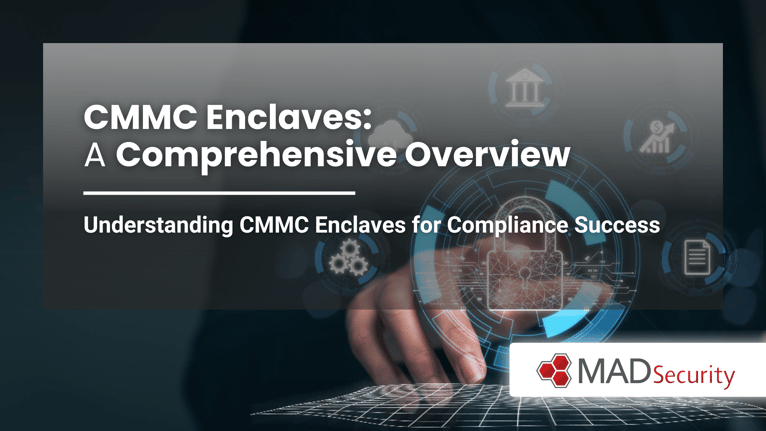
In the rapidly evolving cybersecurity landscape, defense contractors face the monumental task of protecting Controlled Unclassified Information (CUI) in compliance with the Department of Defense’s (DoD) Cybersecurity Maturity Model Certification (CMMC) framework. One of the most effective strategies for achieving CMMC compliance is the implementation of CMMC enclaves. In this detailed guide, we will explore the concept of CMMC enclaves, their benefits for compliance, and the essential steps for their creation and management.
Understanding CMMC Enclaves: What are they?
CMMC enclaves are secure computing environments specifically designed to store, process, and protect CUI within an organization’s broader network. These enclaves act as a fortified area, or a “digital fortress,” where the most sensitive data is isolated and safeguarded with enhanced security measures. Depending on the organization’s needs and resources, they can be physical, virtual, or hybrid.
The Role of CMMC Enclaves in Compliance

- Enhanced Security for Sensitive Data: By isolating CUI in enclaves, organizations ensure that their most critical data receives the highest level of protection against unauthorized access and cyber threats.
- Streamlined Compliance Process: Concentrating CMMC controls within the enclave simplifies the compliance process, making it more focused and manageable.
- Cost-Effectiveness: By reducing the scope of compliance, organizations can allocate resources more efficiently, avoiding the unnecessary expense of securing their entire network to the same stringent level.
The Role of CMMC Enclaves in Compliance
Building a CMMC enclave involves multiple phases and requires careful planning and execution. Here’s a breakdown of the key steps:
- Planning and Scoping
- Discovery: Conduct a thorough CMMC readiness assessment of your current cybersecurity posture, focusing on identifying gaps and risks related to CUI protection.
- Data Inventory and Classification: Classify all CUI within your organization, determining which data needs to be stored and processed within the enclave based on its sensitivity and criticality.
- Enclave Scope Definition: Define the boundaries of the enclave, including which systems, applications, and data will be included. Consider factors like workload size, performance needs, and potential future growth.
- Risk Assessment and Threat Modeling: Analyze potential threats and vulnerabilities relevant to your CUI environment and the chosen enclave implementation. This helps design appropriate security controls and mitigation strategies.
- Budget and Resource Planning: Estimate the costs and resources required for building, deploying, and maintaining the enclave, including hardware, software, personnel, and training.
- Design and Deployment
- Enclave Architecture Design: Define the technical architecture of the enclave, including its physical or virtual configuration, network segmentation, and data isolation mechanisms.
- Technology Selection: Choose the hardware and software components that meet CMMC requirements for your enclave environment. This includes secure operating systems, encryption technology, and access control systems.
- System Hardening and Configuration: Configure all enclave systems and applications to adhere to CMMC security controls, including access control policies, logging and monitoring, and vulnerability management practices.
- Integration and Testing: Integrate the enclave with existing systems and network environments, ensuring seamless and secure data transfer and access. Conduct rigorous testing to verify the functionality and security of the enclave.
- Operation and Maintenance
- Identity and Access Management (IAM): Implement strict IAM protocols to control access to the enclave, including multi-factor authentication, least privilege principles, and user activity monitoring.
- Continuous Monitoring and Logging: Continuously monitor enclave activity for suspicious behavior and maintain detailed logs for audit purposes. Develop incident response plans for potential security breaches.
- Security Awareness and Training: Train personnel who access or manage the enclave on CMMC requirements, cybersecurity best practices, and proper data handling procedures.
- Regular Maintenance and Updates: Regularly update enclave software and firmware to address vulnerabilities and maintain compliance with CMMC. Conduct periodic penetration testing and vulnerability assessments to identify and address emerging threats.
- Additional Considerations
- Seek guidance and assistance from CMMC expert consultant organizations like MAD Security to guide your enclave development process.
- Leverage existing security controls and technologies wherever possible to optimize efficiency and resource allocation.
- Explore the feasibility of cloud-based enclave solutions, which can offer scalability, flexibility, and reduced infrastructure costs.
- Stay up-to-date with the evolving CMMC requirements and adjust your enclave accordingly.
Deciding to Build a CMMC Enclave:
Should you build one?
The decision to build a CMMC enclave should be based on several factors, including the volume and sensitivity of CUI handled, existing cybersecurity infrastructure, and budget.
While enclaves provide significant benefits regarding focused security and compliance, they also introduce complexities in implementation and management. For some organizations, alternatives like managed cybersecurity services might be more appropriate.

Long-Term Benefits of CMMC Enclaves
Beyond immediate compliance, CMMC enclaves offer long-term advantages:
- Enhanced Security Posture: The focused protection of CUI in enclaves significantly reduces the risk of data breaches and cyberattacks.
- Improved Reputation and Trust: Demonstrating a commitment to CMMC compliance through enclaves builds trust with clients and partners, particularly within the defense sector.
- Competitive Advantage: Compliance with CMMC can open doors to new contracts and opportunities in the defense industry.
Conclusion
Establishing a CMMC enclave is one possible step for defense contractors in protecting CUI and achieving compliance with the CMMC framework. Enclaves can provide a secure environment for sensitive data through careful planning, the right technological approach, and ongoing management. Consulting with experts like those at MAD Security can ensure that your CMMC enclave is compliant and effectively integrated into your broader cybersecurity strategy. For more information or assistance in building your CMMC enclave, contact MAD Security today.
Original Published Date: January 23, 2024
By: MAD Security

